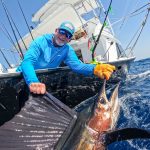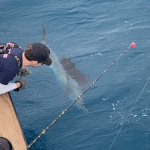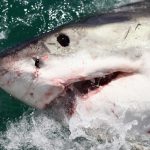Article Courtesy: floridasportsman.com | Originally Published: 12/3/20 | Click here for original article
Four Hundred Miles From Home, Amidst Two Hurricanes
Suddenly, complete darkness. “No, it can’t be,” thought Capt. Dalan Markett, staring at a blank screen which had been displaying the route home and other essential navigational information. Making headway had been slow, like 12 knots slow. The captain had been running with all nonessential lighting off, or tuned to emit as little light as possible, so the FLIR thermal imaging camera could be used to identify potential hazards in the 8-foot seas.
“Now what?” inquired Tom Bradley, the boat’s owner and longtime friend of the captain. Bradley had been riding co-pilot, taking every third wave just as begrudgingly as Dalan.
“We just briefly lost our FLIR, and our starboard screen,” said the seasoned captain, with a hint of concern.
“Well, that’s something new,” responded Bradley.
Both men were crusted with salt from the relentless beating they had endured for the last eight hours, attempting to cross an angry Gulf of Mexico in a center console fishing boat. It was just after midnight and they were still over 250 miles from home.
Up until this point, Dalan had taken in stride changes of plans, storms and breakdowns. “Improvise, adapt, and overcome, always be prepared for the unexpected,” he’s fond of saying. He’d made similar long-range trips in a center console boat with Tom to destinations like Cat Island, Bahamas and Isla Mujeres, Mexico. Overcoming equipment failures, environmental challenges, logistical nightmares, and unforeseen anomalies was simply part of the adventure. But, Dalan emphasized in the retelling: “The last two hours before we made the decision to go, things got real.”
There had never been two hurricanes in the Gulf of Mexico at the same time before. Never.
Before leaving Venice, Louisiana, Dalan and Tom had been sitting in their 56-foot houseboat rental moored in the last slip on “Houseboat Row” in Venice Marina, intently studying every source of weather information they could get their hands on. This had been their Louisiana base of operations for the last 13 days. Dalan and his St. Petersburg, FL crew were looking at the real possibility that in the next few days a climatological record would be set with Tropical Storm Laura and Tropical Storm Marco. Both were forecast to reach hurricane strength, entering the Gulf of Mexico simultaneously. Was this to be the Gulf’s “perfect storm?”
“Is this really happening?” Dalan remembers asking Tom.
The guys knew they couldn’t stay in Venice. Both storms were forecast to intersect over Louisiana as at least Category 2 hurricanes.
“Riding out one Cat 2 in a houseboat would be less than pleasant, but two? Besides, there would likely be no power, which means no fuel, no supplies, and tons of debris coming down the river after the storms,” Dalan later recalled. “When marinas in Biloxi [MS] and Orange Beach [AL] both told us they were closed for transient boats because of the storm, for the first time we all started getting nervous. It looked like the closest marina that would take us was in Panama City, over 280 miles away, and they only had one slip available.
“Looking at a 280-mile run to Panama City versus heading back to St. Petersburg at just over 420 miles away, we made the decision to head home with Ryan Harrington trailing us in a support vehicle on land.”
The forecast was for steady 20 mph south-southeast winds, which would put them quartering on the bow. The crew departed Venice for St. Petersburg at four o’clock in the afternoon. Was this the best decision?
As Dalan tried to find a comfortable running speed, he thought about other long-range trips that he and Tom had been on. Thought about the lingering pandemic, which had cancelled their plans to go to Providenciales, Turks and Caicos, earlier this year, and how many others all over the world it was affecting. Dalan thought about the overnight Loop tournaments they’d fished when poor forecasts seemed to be the norm. Also how the meteorologists somehow missed an early season cold front the day of a kingfish tournament. But this was different. Never before had two named storms become hurricanes in the Gulf of Mexico at the same time. And he was in it. Four hundred miles from home.
At a very slow and uncomfortable 12 miles per hour, into consistent 6- to 8-foot seas, the trip home was going to be a long one. But then a 10-footer, straight on the nose, had Dalan thinking about the option, quickly dismissed, of running 200 miles up the Mississippi River, or the 280-mile run to Panama City.
With a succession of white caps on top of steep 8-footers, the rhythmic pounding allowed Dalan to think back to the first morning in Louisiana. He thought of untying the 42-foot Yellowfin from the front porch of their houseboat and making the 32-mile run to the mouth of the river and prospects of getting bait. The fishing had been easy and predictable.
Dalan and Ryan later recounted these details of the trip to Florida Sportsman:
“I was planning on taking a week or so to get it dialed in,” Dalan said. “But, after the first day, when we caught four 40- to 60-pound yellowfin tuna and two swords, we simply repeated the routine for the next 12 days of fishing.
“There were about 40 charterboats leaving Venice each morning before daylight. All 40 ended up at the mouth of the south passes, 32 miles or so from Venice Marina, at about the same time to catch bait. All in all, it took about an hour and a half to two hours. Then two-thirds of the boats ended up at the same oil rig, floating in 4,000 feet of water, about 70 miles from the mouth of the river. And on our way back, about a third of those boats could be seen sword-fishing, in about 1,300 feet of water.
“There isn’t anything too complicated to find productive fishing rigs, you simply listened for the names of the rigs people were fishing—and talking about. Most of them are marked on our Navionics, StrikeLines and CMOR maps and are relatively easy to find. We also use services like ROFFS, Hilton’s, and RipCharts to eliminate the guesswork of where the good water will be interacting with the rigs. Shoot, even if you didn’t hear where the fleet was going you could see what direction they were headed and use your GPS map to show you what rigs were in the area they were traveling. We ended up fishing five different rigs over the twelve days. Fishing was good on every one of them.”
Captain Ryan Harrington, part of Dalan and Tom Bradley’s crew, explained that they caught four to six yellowfin tuna each day and that they averaged 40 pounds. The setup was pretty basic, four lines in the water, bump trolling to keep the lines straight, the bait natural, and boat in position, while using fairly light 40-pound class conventional reels spooled with 65-pound braid, a 100-foot top shot of 40-pound line and 15 feet of 60 pound fluorocarbon leader tied to 6/0 3x circle hooks.
For bait, pretty much the entire fleet was slow trolling the 10- to 12-inch pogies (menhaden) that were caught at the mouth of the river. Ryan chose to simply hook them through the nose for the surface baits, and the shoulder for the deep baits. He mentioned that a few boats were trolling lures but most opted to troll live bait. Not too different than live baiting for kingfish. Just slower, Ryan said.
“After three or four hours the fleet would start to disperse, some would go to other rigs, but several would go swordfishing, which we did several times as well. It was a no brainer,” Ryan recounted. “The humps, which run about five miles in 1,300 to 1,500 feet, was where the fleet went, and so did we. We didn’t get skunked one time. Every day we caught two or three fish in the 60- to 150-pound range, but while we were there a boat not far from us caught a 308-pounder, a new Louisiana state record.”
Dalan had been reflecting on the great fishing—the easy swordfishing, the lack of current—when a 10-foot wave sent spray high above the tower, ending not only his reverie but his night vision. Without the aid of their thermal imaging camera and starboard Simrad screen, the captain brought the boat off plane to reassess their options. A quick glance at their remaining functional Simrad screen confirmed their fears: St. Pete was still a miserable 264 miles away, a number that seemed impossibly far to both men.
Dalan began the search for a suitable “bail out” location that would offer adequate facilities and protection from the approaching storms. Their options were very limited due to the sparsely populated coastline of the “Big Bend” area of North Florida. Panama City, at 148 miles, seemed to show the most promise for a suitable wharf. As he scanned the chart for larger facilities that could accommodate their vessel for a few days, his thoughts trailed off to Hurricane Matthew and the devastating effects it had on that area just the previous year. Would those marinas even still be there?
“After a short discussion we agreed it was the safest and most prudent decision to head to Panama City instead of trying to make it home,” Dalan later recalled. “It was not an easy decision, not knowing what we would find when we got there, but with the change in course we could make better time, and not get beat up nearly as bad, so we committed to it and never questioned it.
“We figured we would just pull into a slip at the biggest marina on the map and work it out with the dockmaster in the morning when they opened. Boy were we in for a surprise. We pulled up to the Panama City Marina at about 5 a.m. and there was nothing, no docks, no boats, no fuel, just a bunch of busted off pilings and debris left from Hurricane Michael.”
It was an ominous scene. Dalan remembers shuddering to think the area might be facing another round of devastation.
“We tied up the best we could to the broken pilings and got a couple hours rest,” he recalled.
The next morning brought its own set of challenges to the men. There were fewer than half the marinas in Panama City that there were a short year ago, and of those only a couple had fuel available. After calling all the marinas in the area for transient dockage, they were able to secure the last spot available at a friendly local marina called Bristol Harbor.
“The dockmaster helped us tie up, and watched over the boat during the next week while we made plans to come back and bring her home. Ryan was driving Tom’s truck home from Venice with our enclosed tackle trailer and was able to swing by and pick us up.
“I don’t think I have ever been so glad to see his smiling face,” said Dalan of Harrington.
The men were battered and worn, but they were safe, and they were almost home. Ten more hours of traveling seemed markedly more acceptable knowing they weren’t looking for that next 10-foot wave. As the sound of the highway serenaded him to sleep, the weary captain couldn’t help but reflect on the last two weeks. The GPS in the truck’s windshield caught his attention—402 miles from home.
Making Plans
According to Ryan Harrington, prepping the boat took about a month. Planning for a trip to Venice, LA is much like going to another country. It’s literally a different mindset and culture. When you get there, don’t expect to be able to buy anything but ice and fuel. Bring what you need. “We planned on being there for three weeks. We brought a freezer, which we ran out of room to keep fish after just two days,” exclaimed Ryan.
As for the fuel, with all of the refineries in the area fuel was not only cheap at $3 a gallon, it was also available 24 hours a day. No matter the time you could pull up with your boat, swipe your card and fuel up. This is important because running nearly 200 miles a day everyone needed to fuel up each day. The crew brought on about 300 gallons a day. The boat burned 630 gallons of fuel on the 420-mile trip from St. Petersburg to Venice. The boat’s in deck fuel capacity is 571 gallons, which they used, in addition to 59 gallons of the 200-gallon fuel bladder brought along, leaving 140 gallons in reserve.
Web Addition to 400 Miles From Home DEC/JAN feature:
Long offshore trips whether 60 miles or 400 require a significant amount of time preparing for the trip. First and foremost is attending to the condition and seaworthiness of your vessel. Make time to ensure all your systems are operating properly, such as bilge pump float switches. Also check off that you don’t have any wiring gremlins or small thru-hull leaks, which will rear their ugly heads when put to the test.
Also, you want to have at least one offshore trip since your last engine service, making sure all clamps, hoses, etc. were installed correctly.
Once you have determined that your boat is in “long range” condition, the real work begins.
Dalan Markett, boat captain on the Keep ‘Em Tight out of Pass-a-Grille, Florida, put together his preparation list for us below. “No matter how you provision, it is essential to train with your crew prior to any trip,” Dalan emphasized. “We familiarize ourselves with not only where the equipment is located but also with ensuring everyone onboard is comfortable, confident, and knowledgeable in their uses.”
Boat:
- Float plan filed with knowledgeable persons and updated during transit
- Offshore life raft (with cover) in hydrostatic release cradle
- Sirius weather subscription
- Inflatable PFDs with strobes and PLBs
- Tethered throwable with strobes
- 200-gallon ATL fuel bladder with transfer pump
- Thermal monocular
- ANPVS-3 or higher night vision goggles
- Stabilized binoculars
- High volume manual bilge pumps
- Large tool kit
- Extra filters, belts, hoses, and known wear items for engines
- Extra pumps, relays, and breakers
- Extra props (standard and counter rotating), hubs, and wrench
- Toilet bowl wax rings (to patch small holes in hull)
- Large rubber / wood hole plug (for bigger holes in hull)
- Flex tape
- Camera and notebook
- Copies of photo ID’s, a credit card and small amount of cash
- A great mechanic who is willing to answer the phone at all hours! (Hello Dan at First Choice Marine)
Safety:
- 2 EPIRBS (1 stationary mount hydrostatic release, 1 portable in ditch bag)
- Brightly colored floating ditch bag with the following contents
- Offshore flare kit with extra flares
- Handheld VHF with inflatable antenna
- Satellite Phone with solar charger
- Laminated important phone number list
- Handheld GPS with extra lithium batteries
- Signaling devices (mirrors, dye packs, whistle, air horn, strobe lights, and cyalume light sticks)
- Water bottles with electrolyte packets
- Emergency desalinator (6 person)
- Packaged food rations, hard candy
- Sponges
- Sunscreen and lip balm
- Anti-nausea medication
- Benadryl
- Compass, analog watch, and map
- Sunglasses and hats
- Survival knife/multi-tool, serrated knife
- Basic fishing supplies (hooks, line, small lures)
- Waterproof flashlights
- Thermal blankets
- Cordage for tethering
First Aid:
- AED
- Tourniquets
- Clotting agent
- Trauma supplies (gauze, abd dressings, bandages, tape, etc.)
- CPR mask, gloves, shears, tweezers, scalpel, lighter
- Bag valve mask with OPA’s and NPA’s
- Staple gun and extra staples
- Suture kit
- SAM splint
- Burn blanket and dressings
- Liquid soap and antiseptic wash
- Tincture of benzoin
- Vinegar, hydrogen peroxide, iodine, antibiotic ointment, 151 grain alcohol
- Extra medications for crewmembers
- Benadryl, aspirin, Tylenol, ibuprofen, Imodium, bonine, tums
- Thermometer, stethoscope and BP cuff
- Oxygen bottle and masks / nasal cannulas
- First aid / CPR instructions laminated






